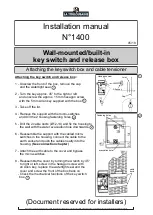
AUI (DB-15 female D-Sub) Connector
The AUI connector provides another port for connecting to a
network via a transceiver or for cascading hubs. NOTE:
Do not cascade hubs together with an AUI cable! If
attaching a transceiver through an AUI cable, use only IEEE
approved Ethernet AUI cables. Maximum distance for an
AUI cable is 50 meters (150’).
Rules For Configuring Your Network
Follow these rules when configuring your network:
* When connecting multiple hubs together on a backbone,
you can use the AUI port of your hub; utilizing a transceiver
(TN models E-CX-MC02, 03, 04 and 05) to attach to the
backbone. A thicknet or thinnet backbone will allow you to
run longer distances between hubs and provide better noise
immunity because the cable is shielded. In addition, fiber
Table 2
Media
Maximum
Maximum
Minimum
Maximum
Segment
Number
Segment
Medium
Medium
Type
MAUs per
Length
Propagation
Delay per
Segment
(meters)
Velocity*
Segment
(nano/sec)
Coax
10Base5
100
500
0.77 c
2165
10Base2
30
185
0.65 c
950
Link
FOIRL
2
1000
0.66 c
5000
10BaseT
2
100***
0.59 c
1000
AUI**1 DTE/MAU
50
0.65 c
257
*c = 3 x 10 to the 8th power, expressed in meters/second
**AUI connection is not a segment
*** Maximum segment length depends on the cable characteristics
Hub LED’s
The 24 port Ethernet hub provides Power, Link, Fault and
Rear Slot Enabled LED’s, for monitoring convenience.
Power is indicated after the unit is plugged into any AC out-
let (100-240 VAC, 50-60 Hz) and with the rear power switch
turned on. Link indicates the hub is receiving link pulses
from a 10BaseT compliant device. Fault LED indicates the
redundancy feature has failed and is not functioning. Rear
Slot Enabled indicates which optional slots are active when
the redundancy feature is utilized.
Redundancy Switch
The redundancy switch is also located on the hub’s side and
is used for the redundancy feature utilizing the optional slide
in cards. Both slots must be installed with any combination
of fiber optic or twisted pair slide in cards.
cable. Use only IEEE approved AUI cables. Check
the connections.
* The network interface card is improperly configured.
Refer to users manual; verify proper configuration.
* Another network device is disrupting communica-
tions of the device your are trying to bring on line.
Remove that device and troubleshoot the problem on
that line.
Integrating Ethernet IEEE 802.3 Compatible Hardware
This information provides guidelines for integrating 10BaseT
and non-10BaseT compatible hardware for use with the 24
port Ethernet hub in your network. The following table sum-
marizes the delays for the various network media segments.




























